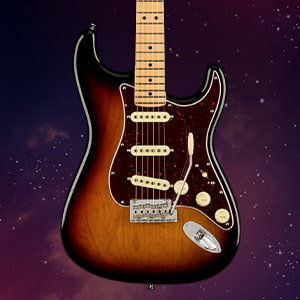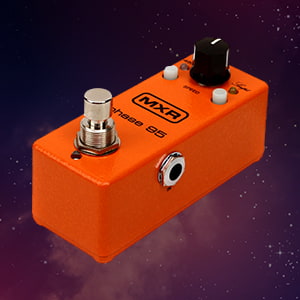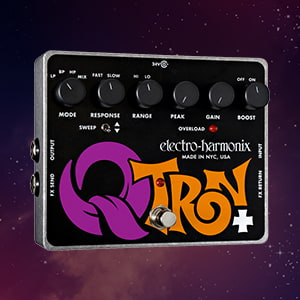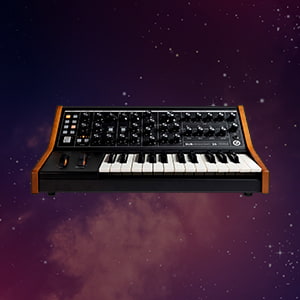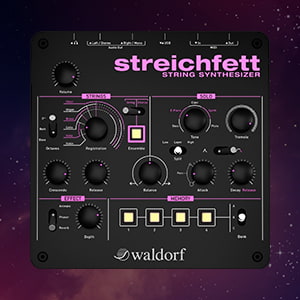Exactly what kind of band is Parliament-Funkadelic? Although the focus of our video above is their totemic single, “Flash Light,” the brains behind it — George Clinton, Bootsy and Catfish Collins, Bernie Worrell, Eddie Hazel, Junie Morrison, and Garry Shider, among many others — were always one group. To distill every nook and cranny of their influence requires a bit more nuance. Rather than look, solely, at all their sterling crew of musicians, let’s take a deep dive into what made them, as a collective, legendary.
From their humble beginnings in Plainfield, New Jersey, they transformed from a doo-wop group known as The Parliaments into something far more nebulous. And in turn, their sprawling cultural and musical ideas would take on mutant shapes of all sorts of genres and styles they helped evolve — psychedelic soul, funk, disco, and electro, to name a few. Whether as Parliament, Funkadelic, Parliament-Funkadelic, P-Funk, or something else, it was their own brand of freak, flying its flag on every bit of territory hit by those under the little light under the sun.
Mommy, What’s a Funkadelic?
There wouldn’t be any true creation story unless it starts out with a bang. It all began for one George Clinton, a sometime barber and hairstylist, when his original doo-wop group The Parliaments dissolved under contractual disputes. Rather than completely give up his artistic aspirations, he took some members like guitarist Eddie Hazel, Lucius Ross, and Ramon “Tiki” Fulwood, and resolved to do something different.
George Clinton and The Parliaments in 1969
Exploring a new groove introduced by the godfather of soul, James Brown, George came up with the idea to name this group Funkadelic — a play on combining funk and psychedelia. In Funkadelic, he could create music with a wigglier bent. As luck would have it, George would also gain back rights to his old group’s name, Parliament. Now owning two groups, rather than jettison his R&B side, why not use Parliament to explore the cool, urban soul mainstream? Now as two groups, Parliament and Funkadelic could cover all sorts of musical ideas and markets.
Free Your A**, and Your Mind Will Follow
The ‘70s introduced a nascent idea of what Parliament and Funkadelic could be. Funkadelic was a hard-nosed funk group led by the sterling guitar work of Eddie Hazel, who tried to introduce the sonics of Jimi Hendrix-style electric blues into the framework others like Sly and The Family Stone or The Chamber Brothers had built.
What initially began as an acid-fried take on funk, on albums like 1970’s Funkadelic and Free Your Mind and Your Ass Will Follow, grew increasingly more out there and experimental. Joined by keyboardist Bernie Worrell, early attempts to go with the musical flow proved too simplistic for Funkadelic. Earth, Wind and Fire they surely weren’t.
1971’s Maggot Brain and its iconic title track pointed at a shift. Blessed with a solo to put all other solos to shame, Eddie played lights out, as if his momma died, and George took to the mixing board, Echoplex-ing the hell out of it, exorcising any idea that this side of the equation would go anywhere back to its tamer beginnings. A year later, they would be joined by two wayward musical brothers, Bootsy and Catfish Collins, looking for some freedom they couldn’t experience under the dictatorship of the James Brown band.
Standing On The Verge Of Getting It On
For two years, the whole mythos of Funkadelic started to flower on albums like America Eats Its Young and Cosmic Slop. Finding a way to mix the booty and the mind, Funkadelic took the ideas of funky psychedelia to their logical conclusion, creating longform, sprawling grooves that touched on the trials of urban Black America in far more surreal ways. Now, the bass-heavy ideas of Bootsy took center stage, departing from much of the idyllic, flower power of their earlier days.
However, by the mid ‘70s you’d be hard-pressed to think of any reason why Parliament, as an entity, should exist. Its 1970 debut, Osmium, was deemed a flop. For the sum of three years, the more “accessible” side seemed destined to be put to bed. Things changed in 1974.
Ever mercurial, Bootsy left the collective, despite contributing heavily to its change in course on America Eats Its Young. One can infer that Bootsy’s interest remainedin making music that would be heard by young urban Black America. Merely laying back while someone else played guitar solos would never be his bag. 1974’s Up For The Down Stroke resurrected Bootsy’s ties to the collective, allowing him to contribute their tightest grooves yet on songs like “Up For The Down Stroke,” reintroducing his not-so-oddball but still left-field ideas to the more soulful side of those two groups. 1976’s Chocolate City introduced the iconic P-Funk rhythm section of Worrell-played Minimoog synth and Booty-esque Mutron-filtered Fender bass lines.
The Mothership Connection
Somehow, this flop of a group started to right both ships to their own course. Funkadelic became more insular, taking some of the ideas of the crossover Parliament group and leaning on them for their own sonic explorations. On albums like Let’s Take It To The Stage and the Tales Of Kidd Funkadelic, proggier, glam rock-inspired asides started to take the lean of P-Funk stylings. The outlandish ideas of George Clinton had spurred onstage personas to match the wildly imaginative graphic art adorning their Pedro Bell-designed covers. But one can’t get to that without acknowledging what brought them to it.
Fully owning and expanding on the forward-thinking ideas laid by groups like Sun Ra’s Orkestra, Parliament saw inspiration in the possibilities of taking Black thought into space. Their idea of Afrofuturism, something seeded in 1974, flowered into its own on 1976’s Mothership Connection. On songs like “Give Up The Funk” and “Mothership Connection,” they posited their own ethos: “space is the place.” And armed with their most gargantuan grooves yet, all colors had space on their mothership to ride.
Lean in myriad ways, albums like Mothership Connection and The Clones Of Dr. Funkenstein, showed Parliament to be not a copy of anything, but at the forefront of a new kind of funky music. For two years, understandably, George Clinton set aside Funkadelic, discovering and uncovering a freakier side that (arguably) came to its own on 1977’s Funkentelechy Vs. The Placebo Syndrome.
Critically and commercially acclaimed, Parliament went full id, lacing tracks like “Bop Gun” and “Flash Light” with all sorts of sonic wizardry (courtesy of Bernie Worrell, his trusty Minimoog and a Solina String Machine), taking this idea of knocking disco out of the charts by absorbing it, transforming it, and reinvigorating its ideas through their own freaky lens.
One Nation Under A Groove
If anything proved how far the collective was from its salad days, it would be 1978’s One Nation Under The Groove. Gone were the Zappa-esque attempts at genre-bending, here were the mutant funk stylings and sheer musicianship possible under one band and one groove. Augmented by the ideas of keyboardist Walter ‘Junie’ Morrison and Bernie Worrell, Parliament-Funkadelic came into their own creating songs like the title track and “Groove Alliance.” These were desperately complex rhythmic long players with a hypnotic pull that was impossible to not fall under.
And as fast as other soul bands were discarding their players for synths and drum machines, somehow, Funkadelic found another gear on tracks like “Promentalshitbackwashpsychosis Enema Squad (The Doo Doo Chasers)” and “Into You,” treating fusion and reggae like they were their forlorn lovers. Within the Mothership Connection, this station of Funkadelic finally landed on their own planet of Funkadelia (one that others like A Tribe Called Quest, Pharcyde, and more would later rediscover).
Computer Games
If we’re looking for a coda for the P-Funk journey, it might be found in the music of George Clinton and his early 1982 release Computer Games. Once again at the center of various creative conflicts and music industry machinations, once again trying to figure a way forward, George sought a way to fly his freak flag in this new decade, one obviously inspired by his group but increasingly lapping it in ideas.
Showing a bit of humility and self-awareness, George would receive help from Bootsy, Junie Morrison, Bernie Worrell, and longtime Funkadelic songwriter/guitarist Garry “Starchild/Diaperman” Shider. Influenced by the electro-leaning sound of Zapp’s Roger Troutman, his one-time protege, and in league with the contemporary ideas of Bill Laswell and Herbie Hancock, so too did the teacher try to learn a thing or too, shifting his sound to fully accept the trappings of instruments like drum machines, samplers, synths, and vocoders, taking a stab at creating his own form of future funk. Although the once lost and rejected Funkadelic album By Way of the Drum made its case for being the one, it wasn’t meant to be.
Presenting a wonderful “What if?,” George Clinton’s Computer Games and its followup You Shouldn’t – Nuf Bit Fish shows that the P-Funk sound could have or should have (if all the stars aligned themselves) had another thing to say in this new era where their progeny — hip-hop, electro, techno, and house, shared so much of their DNA. And on songs like the iconic “Atomic Dog,” a passion play between Sequential Prophet 5 and backwards-playing Roland TR-606, we hear perhaps the strongest, final signal of a funky mothership leaving us far too soon.
In our video below we turn our spotlight to one track, “Flash Light,” giving you a glimpse of the brilliant musicality and musicianship behind this wonderfully creative collective vision.
Notes From Our Video
This project, in so many words, was a true labor of love. An homage to the wonderful sounds and musicianship of Parliament. Boiling the band’s seemingly never-ending catalog down to just one video felt like an impossibly cruel task though. What to choose? Even though it was a popular hit, there’s just no denying that the group’s 1978 song “Flash Light” serves as the perfect display of the many reasons why this band was so great at what they did.
The famous bass synth tones. Those layered claps. The vocal refrains. The string synthesizer parts. What’s not to love? The hard part was going to be recreating it while retaining its essence. Thankfully, you can accomplish this using just a handful of instruments, so here’s what I used to create our very own zZounds version of “Flash Light.”
For starters, I opted to work on the rhythm section first – this is a funk track after all. If there’s one tool in the arsenal to really bring the funk, it’s gotta be a Fender Strat. That characteristic spank and quack are perfect for hammering out percussive funk guitar rhythms. I used a Fender American Pro Stratocaster, set to the fourth pickup position, and paired it with a Fender ’68 Custom Deluxe Reverb amplifier for a tight, clear tone with plenty of snap. The final touch was adding in an MXR M290 Mini Phase 95 pedal with the Script mode engaged, and setting the Speed knob to around 9 o’clock. This very slow and subtle phase added plenty of texture to the rhythm guitar part. You’ll notice that on my recording I panned this part hard to the left, just like the original track.
The second guitar part, panned hard to the right, is the same guitar rig but with an Electro-Harmonix Q-Tron+ envelope filter pedal instead. I chose the Band Pass filter setting, which passes only the mid range frequencies, and set the Response knob to Fast. This extra “quacky” sound can be heard panned to the right on the original Parliament recording too.
Let’s be real here though…
The weight of this entire track rests on one key foundation (pun intended): the crushing synth bass tone. Keyboardist Bernie Worrell had stepped in to take over bass duties on this song after Bootsy Collins decided he didn’t want to play the bass part himself. But Bernie had a secret weapon: his Minimoog Model D synthesizer. The Model D turned into a pumping and growling beast, and introduced the world to truly funky bass synthesizer tone. There was nothing like it.
For our video I chose to use my Behringer Poly D synthesizer, and it absolutely nailed the classic bass tone with ease. I discovered it sounded closest when I used a lower octave square wave as my main oscillator, and blended in a triangle wave on top. The third and final oscillator was also a triangle wave, but moved up an octave and then tuned to a fifth interval relative to the main oscillator. I personally use this classic trick to add heft and thickness to my music all the time. It was a delight to see that Bernie appeared to do the same all those years ago.
The oscillators weren’t the only important aspect. The filter section proved crucial in creating Worrell’s shorter staccato bass notes. The key was to decrease the Loudness Contour section’s Attack and Decay knobs to almost zero for an extra short and punchy note. The Sustain knob was set to maximum to not cut the notes off too short. The result was a wonderful pulsing bass line, and I further accentuated this effect with some extra compression added. Just out of respect, I transcribed Bernie’s original bass lines 100% note for note, so be sure to check out his genius licks at work throughout our video.
Bernie being the synth maestro that he was, also laid down an amazing string synthesizer part too. He did it on an old ARP String Ensemble synthesizer, and weaved in a formidable number of licks in the background of the song. Because there’s no chance I’ll ever get my hands on a real ARP, I went with the Waldorf Streichfett String Synthesizer to replicate that sound. This synth was absolutely brilliant at recreating the famous string synth sounds of the ’70s and ’80s. Within minutes I found the exact tone Bernie used on the record, nearly dead on. I had no choice but to faithfully transcribe the original parts because, well, they are the best of the best! There are plenty of fun licks to be heard in this part too, so keep your ear on it if you want some fun Easter eggs.
There was still something missing though. That final cherry on top of the project…
The lead synthesizer parts! I truly had my hands full in figuring these out but realized something: I could get all of them with the Behringer Poly D synth. Not only did it cover the bass synth duties, it doubled on all of the solo leads too. Major bonus points. Rather than go into detail about the multitude of tones and settings that I used, just know that clever manipulation of the oscillators and filters will achieve all of the sounds that are heard.
– Justin

